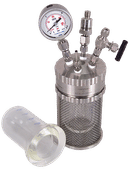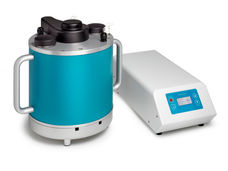In search of a clean and inexhaustible energy source
Advertisement
nuclear fusion is produced when two atomic nuclei of light elements are joined giving way to heavier elements, thus releasing an enormous amount of energy. In order for this reaction to be produced, a large input of energy is necessary to reach temperatures of tens of millions of degrees that allow the nuclei to get close enough so as to overcome their natural repulsion and then be condensed into the plasma state.
However, once under way, the process can sustain itself with minimum exterior energy input, forming what is called plasma ignition. In order to keep these plasmas from coming into contact with any material medium, one of the methods employed in some fusion reactors is magnetic confinement which consists in isolating the plasma in an empty chamber through magnetic fields. "One of the problems is that these types of plasmas are by nature very unstable and are dominated by the turbulence that appears in the interior and makes the plasma as well as its energy go out very quickly from the magnetic recipient that confines it", professor Raúl Sánchez explained, that has focused his research on the area of plasma physics and thermonuclear fusion, particularly in the theoretical and basic study of the physics of systems for magnetic plasma confinement, employed by the Tokamak reactor prototype ITER, which is currently under construction.
The success of this way of producing energy requires avoiding the appearance of these instabilities or controlling them if they do appear, as well as the turbulences that dominate the interior and greatly accelerate the deterioration of the confinement. In recent decades enormous advances have been made in this direction, but deuterium plasmas have been used which do not produce high energy neutrons and are, as such, easier to operate. The fusion of deuterium and tritium is, however, the most energetically accessible, since it requires a lower temperature. For that reason, there are still many challenges to be met, such as those that have to do with the introduction of tritium, which is an unstable isotope; or the proof that these plasmas can enter into ignition, that is "self-heat" with the energy stored by the helium atoms produced in the fusion reactions. "Moreover", the researcher added, "the fusion of tritium and deuterium, the two elements that are used, produce large fluxes of very energetic neutrons that go towards the walls of the reactor, for which materials must be found that are capable of supporting these fluxes", he concluded. With the aim of meeting all these challenges, the international community, including Spain, has started up the ITER Project, a reactor of this type that is being constructed in the south of France with a budget of 200,000 million Euros. The future of this energy source, which is in theory clean and inexhaustible, depends on the project's success.
Professor Raul Sanchez has been working within the UC3M Plasma Physics Group where he and his colleagues attempt to understand from a theoretical point of view the dynamics of the turbulence that dominates these plasmas or their magneto- hydrodynamic stability. The variety of the phenomena that appear in these plasmas is so great that they require the researcher who studies them to have a command of many areas of physics, from electromagnetism physics to statistical physics, including atomic physics, the physics of fluids, and special relativity physics. "We are a relatively small but internationally very active group, working with tokamaks reactors (as in the ITER project) as well as in other fusion mechanisms, such as the stellarator or the reversed-field-pinch", the expert noted.
Noteworthy in his research is the study of MHD stability of plasma confining magnetic configurations. In this sense, the COBRA code developed in 2000 for the calculation of this stability, is a standard tool that has been used extensively in the most important fusion laboratories in the words, such as in the design of the NCSX stellarator and the QPS of the National Oak Ridge Laboratory, as well as for the interpretation of experimental results of the TJ-II heliac of CIEMAT, the W7-AS helias in Germany, and the LHD torsatron of Japan. At the moment the SIESTA code is being developed to resolve magnetic equilibriums with islands and stochastic regions which can be converted into a very useful tool for ITER as well as for the design of the best configurations of reactors in the future, according to the researchers. All these activities have contributed to advancing in a relevant way the knowledge of fusion energy, and thus achieving important international prestige.
The researcher received the news of the prize while in the United States during a stay at the National Laboratory of Oak Ridge, where he works in several projects related to the study of turbulence, transport and stability of magnetically confined fusion plasma as he has done now for several years together with other individuals from the University's Department of Physics. "I was thrilled when I heard the news as it represents recognition of my work and that of my collaborators over the years, and also because I hope that it will help our small but spirited scientific community which carries work out in the area of plasma fusion and physics to achieve recognition in this country", he stated.
The "Miguel Catalán" awards for scientific achievement aim to stimulate and foment research and to foster, recognize and honor the scientific and humanistic values of researchers with links to the Community of Madrid; researchers, who through their work, have contributed to the betterment of knowledge, progress and dignity for mankind. This particular prize, earmarked for researchers under the age of 40, amounts to 21,000 Euros for the honored recipient. The prize, in recognition of excellence in research, values the career and the impact of the work carried by this professor from the UC3M Department of Physics, which collaborates closely with the University of Alaska at Fairbanks and the Oak Ridge National Laboratory of Tennessee (USA), a center of worldwide importance in plasma and fusion technologies.



































































